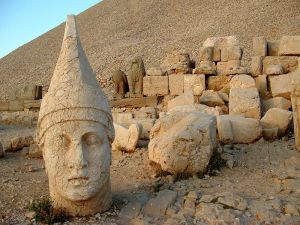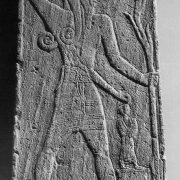God made a puzzling statement to Abraham while establishing His covenant with the patriarch, linking the time that Israel would sojourn in Egypt to the behavior of one group of people.
Then the Lord said to Abram, “Know for certain that your offspring will be sojourners in a land that is not theirs and will be servants there, and they will be afflicted for four hundred years. But I will bring judgment on the nation that they serve, and afterward they shall come out with great possessions. As for you, you shall go to your fathers in peace; you shall be buried in a good old age. And they shall come back here in the fourth generation, for the iniquity of the Amorites is not yet complete.” (Genesis 15:13–-16, ESV)
Iniquity is easy enough to understand; it means sin, vice, or immorality. But what did the Amorites do that God found so offensive? Who were these people and where did they come from?
The Amorites first stepped onto the world stage in the middle of the third millennium B.C. The earliest known reference to an Amorite was from the ancient city of Shuruppak, dated to about 2600 B.C. According to the Sumerian King List, Shuruppak, about halfway between modern Baghdad and the Persian Gulf, was the home city of the last Sumerian king before the Flood. That king was either a man named Ubara-Tutu or his son, the hero of the Sumerian flood myth, Ziusudra, the Mesopotamian Noah.
Scholars disagree on the location of the Amorite homeland. There are two main candidates: One is Jebel Bishri, a low mountain range along the west side of the Euphrates River in central Syria. The other is the Diyala River valley, which descends from the Hamrin mountains toward modern Baghdad. This is the traditional border between Iraq and Iran, and between Arab lands to the south and Kurdish territory to the north.
There is evidence for both theories. One of the peaks in the Jebel Bishri range, Jebel Diddi, may be named for an ancient Amorite tribe, the Didanu (or Tidanu, or Tidnum, depending on when and in what language it was written). Or it may be that the tribe was named for the mountain. Either way, the name is important.
Estonian scholar Amar Annus has demonstrated that the name of this ancient Amorite tribe was probably the origin of the name of the old Greek gods, the Titans. That’s significant, because it links the Amorites and their worship of gods connected to the netherworld, such as Molech, Dagan, Baal-Hammon, and the Rephaim, to the sinful angels mentioned by Peter and Jude—the “sons of God” of Genesis 6:1–4, called “Watchers” in Jewish texts of the Second Temple period such as the Book of the Watchers, or what we know now as the first thirty-six chapters of the Book of First Enoch.
Annus also showed that the Watchers were known as apkallu in ancient Mesopotamia long before the Second Temple period. They were considered sages who brought the gifts of civilization to humanity on behalf of Enki, the god of wisdom. That’s similar to the description of the Watchers in Enoch, although the Jewish and early Christian view of “gifts” like weapons, witchcraft, and mating with human women to produce giants was considerably less favorable than in, say, Babylon.
How do Watchers differ from run-of-the-mill angels? Unfortunately for us English speakers, our language lacks the richness of some others. The word “angel,” borrowed from the Greek angelos (“messenger”), hides the fact that there are several classes or categories of angel, such as malakim (“messenger”), cherubim, seraphim, ophanim (the wheels of Ezekiel’s vision), and others. Based on the use of the term in Enoch, it’s clear that Watchers were especially powerful and exercised free will. Their decision to commit what they knew was a sin suggests that they also had knowledge of good and evil.
Not coincidentally, the Bible tells us that these rebellious angels were cast into Tartarus, just like the Titans of the Greeks. Although your Bible probably reads “hell” in 2 Peter 2:4, the original Greek names Tartarus as the prison of these spirits. Tartarus is a separate place from Hades, a sort of maximum-security hell reserved for supernatural threats to the divine order. Yet the Amorites (and their descendants, the Phoenicians), Greeks, and Romans continued to worship the old gods, especially the king of the Titans, Kronos (Saturn to the Romans, Baal-Hammon to the Phoenicians). Their offspring, the demigod heroes such as Perseus and Hercules, were, by definition, Nephilim.
By 2000 B.C., the Tidanu tribe had developed a reputation across the ancient Near East of being mad, bad, and dangerous to know—so dangerous, in fact, that the last Sumerian kings of Mesopotamia ordered a massive public-works project directed at these savage Amorites. The kings of the Third Dynasty of Ur, a mighty city-state in what is now southeastern Iraq, built a wall north of modern Baghdad 175 miles long, from the Euphrates across the Tigris to the Diyala. This wall, which one smart-aleck scholar recently suggested was intended to “make Sumer great again,” was built specifically to keep the Tidanu away. We know this because the Sumerian name of the wall literally translates into English as, “Amorite Wall That Keeps Tidanu Away.”
The problem for Ur was that it didn’t keep Tidanu away. More on that later.
So, the big question for scholars is this: Did the Amorites come from the middle of Syria, or did they come from northeastern Iraq/northwestern Iran? The answer may be “yes” to both.
Some scholars believe that Amorites, specifically the Tidanu/Ditanu, began migrating east from around Jebel Bishri sometime in the middle of the tThird mMillennium B.C., moving through northern Mesopotamia and northwest Iran before descending the Diyala Vvalley and entering Sumer from the north. Evidence suggests that Amorites lived farther east into what is now Iran than previously thought, possibly following their flocks through the mountains or setting up trading posts along routes that connected Sumer to people living east of Mesopotamia. Lapis lazuli, a blue stone prized in the ancient world, is still found mainly in northeast Afghanistan, and it was used in art and jewelry in Egypt as far back as 3700 B.C. Merchants hauling cargo through the mountains needed places to eat, sleep, and care for their donkeys, and it appears that some of those ancient caravan stops on the eastern edge of Mesopotamia may have been staffed by Amorites by the time of Abraham in the early second millennium B.C.
We’re limited in how far back we can trace the Amorites. While it’s clear that the Amorites had their own language, most of what we know about it comes from deciphering Amorite names. Almost all of the early written records from the places they lived are in Sumerian or Akkadian. For example, while the moon-god was called Nanna by Sumerians and Sîn by Akkadians, he was Yarikh to the Amorites. But when Amorites came to power across the Near East after 2000 B.C., government documents were still written in Sumerian or Akkadian, even in diplomatic messages sent to faraway countries like Hatti (the Hittites, who controlled most of modern Turkey) and Egypt. So, piecing together Amorite culture and history from tablets written in Amorite will probably never happen. Tracing their movements is only possible by identifying Amorite names in Akkadian and Sumerian records.
While it can’t be proved beyond a shadow of a doubt, evidence suggests that the cult of Kronos, king of the Titans, began where the Amorites were first identified. Stories of the old god did not originate in Greece. Instead, evidence firmly documents the earliest worship of Kronos in northern Mesopotamia (southern Turkey or northern Syria), and older circumstantial evidence points specifically to Jebel Bishri, exactly where the earliest Mesopotamian records place the Amorites.
At the risk of sounding like a television presenter (oh, wait—I am one), I have to ask It’s worth asking at this point: Is it possible that the Titans, called Watchers by the Hebrews, made an infernal bargain with the early Amorites? Was this why the Amorite kings who ruled nearly all the lands of the Bible in the days of Abraham, Isaac, and Jacob traced their ancestry back to one Ditana, the legendary founder of the Tidanu/Ditanu tribe? Could this explain the pride of the Amorites who founded Babylon, whose magicians considered themselves masters of occult knowledge received from the spirit realm before the Flood? Is this why Amorite kings as late as the time of the judges in Israel summoned “the council of the Ditanu” from the netherworld through necromancy rituals?
More important: Is the child sacrifice demanded by the old god, Kronos (and his other identities, Saturn and Baal-Hammon), the reason the practice continues even today?
Almost five thousand years after they emerged onto the world stage, the iniquity of the Amorites is still not complete. The bad news is the Watchers/Titans were not the only gods they served.

Derek Gilbert Bio
Derek P. Gilbert hosts SkyWatchTV, a Christian television program that airs on several national networks, the long-running interview podcast A View from the Bunker, and co-hosts SciFriday, a weekly television program that analyzes science news with his wife, author Sharon K. Gilbert.
Before joining SkyWatchTV in 2015, his secular broadcasting career spanned more than 25 years with stops at radio stations in Philadelphia, Saint Louis, Little Rock, and suburban Chicago.
Derek is a Christian, a husband and a father. He’s been a regular speaker at Bible prophecy conferences in recent years. Derek’s most recent book is The Great Inception: Satan’s PSYOPs from Eden to Armageddon. He has also published the novels The God Conspiracy and Iron Dragons, and he’s a contributing author to the nonfiction anthologies God’s Ghostbusters, Blood on the Altar, I Predict: What 12 Global Experts Believe You Will See by 2025, and When Once We Were a Nation.










Leave a Reply
Want to join the discussion?Feel free to contribute!